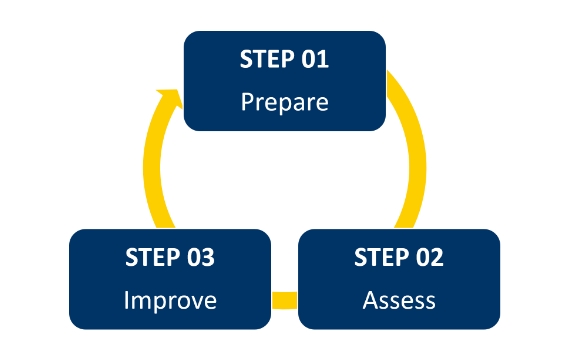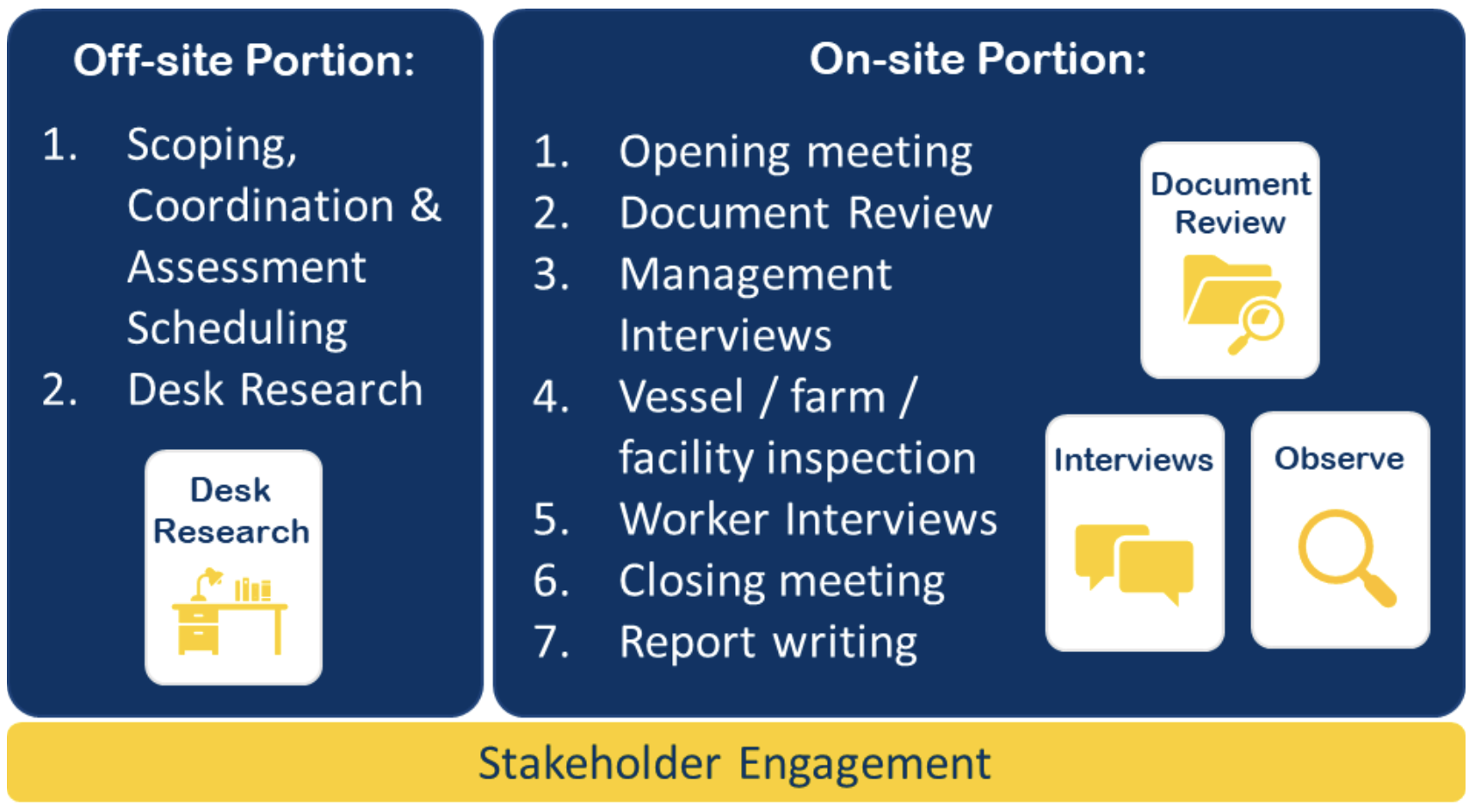
The SRA Process
The SRA can be implemented using a three-step approach: Prepare, Assess, and Improve. This page provides detailed information for each step.
Step 01: Prepare
As you embark on your SRA journey, it is important to understand why, who, where, what, when, and how you are executing the process.
Why have you decided to implement the SRA? What are you trying to achieve? Some examples include:
- A buyer has asked for an assessment of core human rights before they agree to begin or continue sourcing from you.
- You want to understand how to improve the food and livelihood security of the communities in which you work or from whom you source.
- You want to better understand the full range of social risks in your supply chain in order to prioritize interventions.
- You lead or participate in a FIP required to report results on FisheryProgress.org.
There is no one answer to the WHY, but this should be determined before an assessment begins to ensure the scoping of sites and SRA indicators assessed are fit for purpose.
Who will you be evaluating? Which sites are included? These could be fishing vessels, shore-based fishing locations, processing facilities, aquaculture farms, or a combination. You’ll also need to know how many workers are at identified sites to make sure an adequate sample of individuals are interviewed in the assessment. In the SRA, this is known as the Unit of Assessment.
Where are your sites located? The following are some key elements to take into consideration:
- Have you chosen sites in the same region/country?
- How geographically distant are sites from one another?
SRA results are processed at the level of the Unit of Assessment. Sites in different countries/regions, or even communities that are geographically far away from each other, may face very different challenges and therefore different levels of risk on certain indicators. These factors should be taken into consideration when defining the Unit of Assessment.
What will be the focus of the assessment? Depending on the objective of the assessment (your WHY), you may decide to assess all SRA indicators, or you might focus on only a subset of those indicators.
In order to gain a complete picture of risks within a supply chain and/or region, it is strongly recommended to consider assessing all SRA indicators. If circumstances prevent a full assessment, you could consider a phased approach where different components of the SRA are assessed over time to reduce costs and any logistical difficulties.
When will you conduct the assessment? Decide on a timeline for when you would like the assessment to be complete. Some guidelines on choosing timing:
- You will want to complete an assessment during peak season, therefore for seasonal operations, be sure to plan your assessment accordingly.
- The assessment may take several days, and possibly weeks, depending on the scope. This should be taken into consideration when choosing when an assessment will take place to ensure the Unit of Assessment can accommodate an assessment for that length of time.
How will you conduct the assessment? Depending on your WHY, implementation of the SRA may take different forms. The most effective assessments are completed by individuals or teams with proper qualifications. For internal programs, there may be internal staff dedicated to conduct assessments. Where third parties request an assessment, they may require assessors/assessment teams to meet certain qualifications.
The cost of an SRA can be drastically different depending on the scope of the assessment and the assessor/assessment team. It is important to identify the source of funding to cover the costs of the assessment and any remediation/mitigation actions that may need to be implemented after the assessment is complete. Furthermore, it is recommended to conduct follow-up assessments on a regular basis, which should also be taken into consideration for future funding.
The following resources can be used during the Preparation step:
This document walks you through key components of the Preparation and Assessment steps, highlighting best practices, and includes instructions on scoping, sampling, scheduling, and more. It also provides an in-depth overview of what is needed to ensure the assessor/assessment team are qualified to undertake an SRA.
This Excel template helps to calculate a recommended assessment schedule for the SRA. This is meant to be a starting point on which to build, and flexibility should be built into the schedule according to other characteristics.
As the SRA has been deployed across different scales of fisheries, farms, and processing sites, guidance has been developed to streamline implementation of the SRA in those contexts. These interpretation documents provide users with line-by-line guidance on how to interpret the SRA for different types of Units of Assessment.
The current version of these interpretation documents were informed via research and stakeholder engagement. They are being published in draft form pending additional stakeholder outreach directly with fishers, farmers, and workers.
We encourage those conducting SRAs in any of these contexts to reference these documents for your assessment. If you happen to use one of these documents to conduct an SRA, we would like to hear from you. Please email any comments or feedback to SRAsupport@elevatelimited.com.
Guidance materials have been developed to make implementation of the SRA tool simple in supply chains seeking or maintaining certification:
- Start by learning how to use the equivalency mapping: Applying and Using the SRA Tool Equivalency Mapping.
- Review the equivalency mapping of the relevant standard to easily identify evidence from your social audit that can be used in the SRA. The following standards have already been mapped to the SRA:
- Responsible Fishing Vessel Standard, version 1.0
- Fair Trade USA Capture Fisheries Standard, version 1.1.0
- AENOR Atun de Pesca, 195006:2016
- FISH Standard for Crew, Version 1.0
Don’t see the program you are working on? LRQA can help develop additional mapping to other standards and codes of conduct as needed. Reach out and request additional equivalency mapping at SRAsupport@elevatelimited.com.
Step 02: Assess
Once you’ve scoped and planned the SRA and feel prepared, it’s time for the assessment. An SRA generally will take place according to the following steps:

Following the assessment, the results can help devise actions to drive improvement. This improvement plan should utilize a worker-driven approach, whereby fishers and workers are informed of the results and are consulted on ways to improve.
The following resources can be used during the Assessment step:
On this page you will find details about where to find qualified assessors to undertake the SRA or apply to be recognized as a qualified assessor.
Step 03: Improve
Once you’ve finished your assessment, you’ll know which issue areas have the highest risk. Based on those findings, a plan should be created to address the issues that were revealed.
Take Action
An effective Improvement Plan includes the following:
- Defined clear roles and responsibilities: Accountability is important to enable an effective Improvement Plan.
- Prioritization: There may be a number of findings that need to be addressed, and this can be overwhelming if you don’t prioritize. Prioritization should take into consideration the level of risk, the actions that are needed, and costs, among others.
- Root Cause Analysis: This technique will help you to better understand the findings from the assessment. It aims to reveal the factors that caused or contributed to a problem, which is important to understand when developing an Improvement Plan.
- Module 4 of the Approaches to Gathering and Validating Data in Social Responsibility Assessment online training provides information about how to conduct root cause analysis.
- Research: Once you have gotten to the root of an issue or risk area, conducting research in the area will better inform actions to be taken. There are multiple resources available to support further research:
- Categories of Human Rights
- Driving Improvements in Food, Nutrition, and Livelihood Security: Guidance for Principle 3 of the Monterey Framework
- A Trusted Voice for Workers on Fishing Vessels: Accessing Effective Grievance Mechanisms
- Understanding and Accessing Rights: Respecting Human Rights in Fishery Value Chains
- Use a Fisher/Worker-driven Approach: Fishers, farmers, and workers are directly affected by the changes that will be made, and they know better than anyone what the issues are. They may also have helpful insights regarding changes that can be made to the workplace to improve their overall well-being. Discussing the results with fishers, farmers, and workers is an important step to drive improvement.
- Define Specific Actions: Actions cannot be vague – be sure to be specific when deciding what actions will help you to mitigate the risks identified in the SRA.
